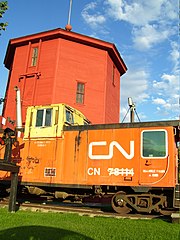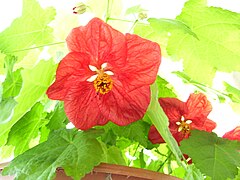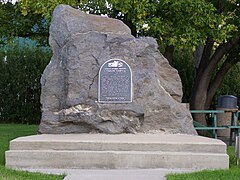User:Limulus
Interesting Items[edit]
Articles I've Done Significant Work On[edit]
(though not necessarily recently)

- Anderson Cooper
- Carl Linnaeus, and related articles:
- Flibe Energy and Closed-cycle gas turbine
- Gee Gee James
- Harris, Saskatchewan
- Internet Explorer for UNIX
- Judith Reisman
- Krampus (mostly images and IPC section)
- No-analog (ecology)
- Pandora's Promise
- Pirate Baby's Cabana Battle Street Fight 2006
- Toxicofera (formerly "Venom clade" :)
- Template:Actinides vs fission products
- Template:Ra to Es by HL
- Voodoo Science
Thorium[edit]
By 1946, only eight years after the discovery of nuclear fission, three fissile isotopes had been publicly identified for use as nuclear fuel:[1][2]
- Uranium-235, which is already fissile, but occurs as <1% of natural uranium
- Plutonium-239, which can be bred from non-fissile Uranium-238 (>99% of natural uranium)
- Uranium-233, which can be bred from non-fissile Thorium-232 (~100% of natural thorium; about four times more common than uranium[3])
Th-232, U-235 and U-238 are primordial nuclides, having existed in their current form for over 4.5 billion years, predating the formation of the Earth; they were forged in the cores of dying stars through the r-process and scattered across the galaxy by supernovas.[4] Their radioactive decay produces about half of the earth's internal heat.[5]
For technical (outlined in a section below) and historical reasons, the three are each associated with different reactor types. U-235 is the world's primary nuclear fuel and is usually used in light water reactors. U-238/Pu-239 has found the most use in liquid sodium fast breeder reactors. Th-232/U-233 is best suited to molten salt reactors (MSR).[3]
Alvin M. Weinberg pioneered the use of the MSR at Oak Ridge National Laboratory. The Aircraft Reactor Experiment in 1954 and Molten-Salt Reactor Experiment from 1965 to 1969 both used liquid fluoride salts; the latter notably demonstrated the use of U-233 as a fuel source.[6] Unfortunately for MSR research, Weinberg was fired and the MSR program closed down in the early 1970s,[7] after which research stagnated in the United States.[8][9]
-
The earth's uranium and thorium originated in the death throes of ancient stars
-
Thorium is relatively abundant in the earth's crust
-
Tiny crystals of Thorite, a thorium mineral, under magnification
-
Liquid FLiBe salt
-
Molten Salt Reactor at Oak Ridge
Sorensen-related
- Energy From Thorium Sorensen's website "Devoted to the discussion of thorium as a future energy resource, and the machine to extract that energy–the liquid-fluoride thorium reactor."
- Thorium Energy Alliance Conference Proceedings
- Kirk Sorensen - A Global Alternative @ TEAC4 Kirk Sorensen's presentation at Thorium Energy Alliance Conference #4 in Chicago.
- Manchester Report: Thorium nuclear power
- Uranium Is So Last Century — Enter Thorium, the New Green Nuke
- Forbes article: Is Thorium the Biggest Energy Breakthrough Since Fire? Possibly.
Thorium in India (map)[edit]
For Occurrence of thorium based on File:India-locator-map-thorium2012.svg updated with [1]

Selected Pictures I've Taken[edit]
-
at the Harris Museum


References[edit]
- ^ UP (29 September 1946). "Atomic Energy 'Secret' Put into Language That Public Can Understand". Pittsburgh Press. Retrieved 18 October 2011.
- ^ UP (21 October 1946). "Third Nuclear Source Bared". The Tuscaloosa News. Retrieved 18 October 2011.
- ^ a b Hargraves, Robert; Moir, Ralph (2010). "Liquid Fluoride Thorium Reactors" (PDF). American Scientist. 98 (4): 304–313.
{{cite journal}}: Unknown parameter|month=ignored (help) - ^ Synthesis of heavy elements
- ^ The KamLAND Collaboration (2011-07-17). "Partial radiogenic heat model for Earth revealed by geoneutrino measurements". Nature Geoscience. 4: 647–651. doi:10.1038/ngeo1205.
- ^ Rosenthal, M.; Briggs, R.; Haubenreich, P., Molten-Salt Reactor Program: Semiannual Progress Report for Period Ending August 31, 1971 (PDF), vol. ORNL-4728, Oak Ridge National Laboratory
- ^ H. G. MacPherson (1985-08-01). "The Molten Salt Reactor Adventure". Nuclear Science and Engineering. 90: 374–380.
- ^ Weinberg, Alvin (1997). The First Nuclear Era: The Life and Times of a Technological Fixer. Springer. ISBN 978-1563963582. Retrieved 12 November 2011.
- ^ "ORNL: THE FIRST 50 YEARS--CHAPTER 6: RESPONDING TO SOCIAL NEEDS". Retrieved 12 November 2011.
- ^ "RESERVES OF URANIUM AND THORIUM" (PDF). Department of Atomic Energy (India). 30 November 2016. Retrieved 18 January 2017.











